Enhanced killing of Candida albicans by human macrophages adherent to type 1 collagen matrices via induction of phagolysosomal fusion
- PMID: 15664915
- PMCID: PMC547032
- DOI: 10.1128/IAI.73.2.770-777.2005
Enhanced killing of Candida albicans by human macrophages adherent to type 1 collagen matrices via induction of phagolysosomal fusion
Abstract
Candida albicans, a component of the normal flora of the alimentary tract and mucocutaneous membranes, is the leading cause of invasive fungal disease in premature infants, diabetics, and surgical patients and of oropharyngeal disease in AIDS patients. As little is known about the regulation of monocyte/macrophage anti-Candida activity, we sought to determine if fungicidal activity might be regulated by extracellular matrix proteins to which monocytes/macrophages are adherent in vivo. Compared to monocyte/macrophages that adhered to plastic, human monocytes and monocyte-derived macrophages that adhered to type 1 collagen matrices, but not to fibronectin, vitronectin, or laminin, demonstrated a significant increase in candidacidal activity. The enhancement of monocyte fungicidal activity was maintained over a 4-h period, whereas macrophage fungicidal activity was maximum at 1 h. Although adherence of monocytes and macrophages to collagen matrices concomitantly enhanced the production of superoxide anion, only the fungicidal activity of collagen-adherent monocytes was partially blocked by superoxide dismutase and catalase. Remarkably, we found that only 10% of the phagosomes in C. albicans-infected macrophages that adhered to plastic fused with lysosomes. In contrast, 80% of yeast-containing phagosomes of collagen-adherent macrophages fused with lysosomes. These data suggest that nonoxidative mechanisms are critical for human macrophage anti-Candida activity and that C. albicans pathogenicity is mediated, in part, by its ability to inhibit phagolysosomal fusion in macrophages.
Figures
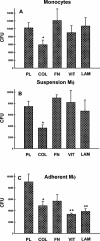
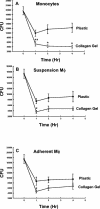
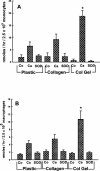

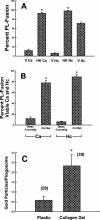
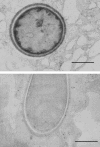
Similar articles
-
Activation of human macrophage fungistatic activity against Histoplasma capsulatum upon adherence to type 1 collagen matrices.J Immunol. 1997 Feb 15;158(4):1779-86. J Immunol. 1997. PMID: 9029116
-
Candida albicans is phagocytosed, killed, and processed for antigen presentation by human dendritic cells.Infect Immun. 2001 Nov;69(11):6813-22. doi: 10.1128/IAI.69.11.6813-6822.2001. Infect Immun. 2001. PMID: 11598054 Free PMC article.
-
Macrophage interactions with Candida.Immunol Ser. 1994;60:505-15. Immunol Ser. 1994. PMID: 8251590 Review.
-
Regulation of human monocyte/macrophage function by extracellular matrix. Adherence of monocytes to collagen matrices enhances phagocytosis of opsonized bacteria by activation of complement receptors and enhancement of Fc receptor function.J Clin Invest. 1990 Sep;86(3):703-14. doi: 10.1172/JCI114766. J Clin Invest. 1990. PMID: 2168442 Free PMC article.
-
I want to break free - macrophage strategies to recognize and kill Candida albicans, and fungal counter-strategies to escape.Curr Opin Microbiol. 2020 Dec;58:15-23. doi: 10.1016/j.mib.2020.05.007. Epub 2020 Jun 27. Curr Opin Microbiol. 2020. PMID: 32599492 Review.
Cited by
-
Urinary tract infections and Candida albicans.Cent European J Urol. 2015;68(1):96-101. doi: 10.5173/ceju.2015.01.474. Epub 2015 Mar 13. Cent European J Urol. 2015. PMID: 25914847 Free PMC article. Review.
-
Thriving within the host: Candida spp. interactions with phagocytic cells.Med Microbiol Immunol. 2013 Jun;202(3):183-95. doi: 10.1007/s00430-013-0288-z. Epub 2013 Jan 25. Med Microbiol Immunol. 2013. PMID: 23354731 Review.
-
Live imaging of disseminated candidiasis in zebrafish reveals role of phagocyte oxidase in limiting filamentous growth.Eukaryot Cell. 2011 Jul;10(7):932-44. doi: 10.1128/EC.05005-11. Epub 2011 May 6. Eukaryot Cell. 2011. PMID: 21551247 Free PMC article.
-
Non-canonical activation of IRE1α during Candida albicans infection enhances macrophage fungicidal activity.bioRxiv [Preprint]. 2024 May 2:2023.10.02.560560. doi: 10.1101/2023.10.02.560560. bioRxiv. 2024. PMID: 37873171 Free PMC article. Preprint.
-
Human dendritic cell activity against Histoplasma capsulatum is mediated via phagolysosomal fusion.Infect Immun. 2005 Oct;73(10):6803-11. doi: 10.1128/IAI.73.10.6803-6811.2005. Infect Immun. 2005. PMID: 16177358 Free PMC article.
References
-
- Anaissie, E. J., J. H. Rex, O. Uzun, and S. Vartivarian. 1998. Predictors of adverse outcome in cancer patients with candidemia. Am. J. Med. 104:238-245. - PubMed
-
- Bistoni, F., M. Baccarini, E. Blasi, P. Puccetti, and P. Marconi. 1982. A radiolabel release microassay for phagocytic killing of Candida albicans. J. Immunol. Methods 52:369-377. - PubMed
-
- Butler, K. M., and C. J. Baker. 1988. Candida: an increasingly important pathogen in the nursery. Pediatr. Clin. North Am. 35:543-563. - PubMed
Publication types
MeSH terms
Substances
Grants and funding
LinkOut - more resources
Full Text Sources
Medical
Research Materials

